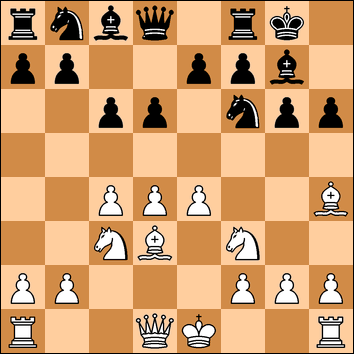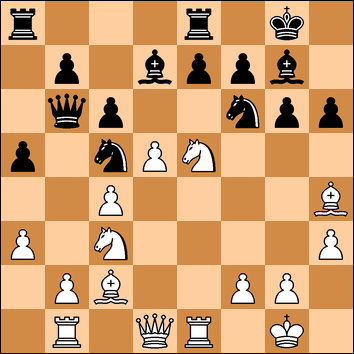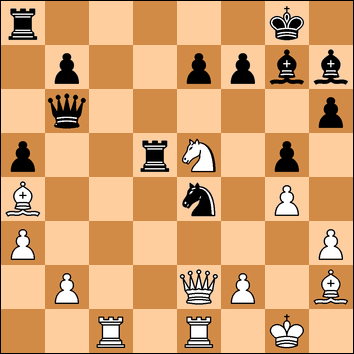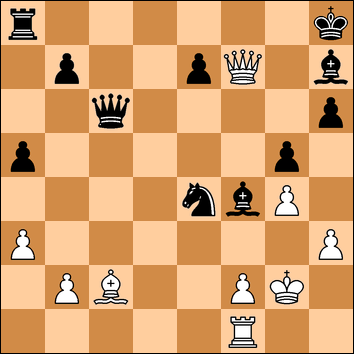Saturday 3 December 2016
White: M. Stockham (124) - Black: K.Nevols (134)
My second match for Kent Under 140s was an away match in Horsham. After some traffic problems, and some difficulty in finding somewhere to park, I arrived at the venue with minutes to spare. A dash around the Horsham Christmas market had not found anything I could devour quickly, so I went straight for the biscuits in the kitchen.
1. d4 Nf6
2. c4 g6
3. Nc3 Bg7
The King's Indian Defence. I am still torn as to whether to commit myself to this opening or find something else.
4. Nf3 d6
5. Bg5 h6
I had recently re-read Andrew Martin's book on the King's Indian which advised an early h6 against a Bg5 - the plan being to deflect the Bishop away from the h6-c1 diagonal, and hence not being able to retreat back home, and allowing Black to play c6 and then Qb6 or Qa5.
6. Bh4 O-O
7. e4 c6
This is modest, however. Martins recommendation is 7. .. c5 to follow with Qa5, exploiting the fact that the bishop now cannot go to d2.
8. Bd3
Playing Be2 is more usual. On this square, the bishop blocks the queen from defending the d-pawn. Black could now consider 8. .. Nh5 beginning an initiative and following with g5 - but I did not like the idea of weakening the area in front of the king before being developed.

8. .... Qb6
Now if White answered with 9. Qb3 I had planned to exchange queens.
9. Rb1 Bg4
If now 10. e5 dxe5 11. dxe5 Nfd7 and Black looks comfortable. 12. Bxe7 can be answered with 12. .. Re8 13. Bd6 Nxe5 (14. O-O Nxd3 15. Qxd3 Bf5 or 14. Be2 Bxc4).
10. d5 a5
White has decided to advance with the d-pawn instead of the e-pawn, and so it is time to develop the queenside.
11. h3 Bd7
12. O-O Na6
13. a3 Nc5
Throughout the last few moves I was concerned about a white pawn advance to e5 but thought I was fine after dxe5; Nxe5.
14. Bc2 Rfe8
Defending the e-pawn in preparation for moving the knight. White could now get a sizable initiative with 15. b4! if 15. .. axb4 16. axb4 Na6 17. e5 dxe5 18. Nxe5 and White has space and momentum.
15. Re1 Nh5?
Whenever I move the knight to h5 (or h4 when White) it is usually a mistaken and this is no exception. The plan is to move the knight to f4 but I really should have preceded this with g5.
16. e5! dxe5
17. Nxe5 Nf6??
Not only proving Black's 15th move was a waste of time, but also a blunder. Black should have played 17. .. Bxe5 18. Rxe5 and let a pawn go (18. .. Kf8? 19. d6!).

Now 18. b4 wins a piece! If 18. .. axb4 19. axb4 Na6 20. Bxf6 and if the bishop is retaken then simply Nxd7. It is hard to give Black any advice here as in all variations, not only is he a piece down but his centre collapses.
18. Na4??
Phew! He doesn't see it.
18. .... Nxa4
19. Bxa4 Bf5
20. Rbc1 Red8
Back in the game - now it is my intention to make some ground in the centre.
21. Qe2?
Lifting a piece off the defence of the d-pawn which allows me to win it.
21. ... g5
Should have played this a long time ago.
22. Bg3 Ne4
23. Bh2 cxd5
OK, so now I am a pawn up but the centre is still very fluid. There are lots of pieces hovering about.
24. g4 Bh7
Those two bishops look quite good side-by-side.
25. cxd5 Rxd5

Now White would be advised to play 26. Nc4, defending the d2 square and attacking the queen, with a possible follow up of Bc2. I am hoping that if I can exchange some pieces off, then my extra pawn could tell in the ending.
26. Qf3??
But White sacrifices a piece as he has seen a tactic.
26. .... Bxe5
27. Bc3
A sudden ping of panic as I had not seen this move at all - however, this was followed by a ping of relief when I realised it did not lead to anything.
27. .... Bxh2+
28. Kg2
Another surprise. I had expected 28. Kxh2 when I was torn between Qd6+ or Rd2.
28. .... Rd2
29. Qxf7+ Kh8
30. Rf1 Bf4
Cutting the queen off from the defence of f2.
31. Rc2 Rxc2
32. Bxc2 Qc6

Now two pieces up I just wanted to finish the game. The only thing I had to be careful about was any perpetual check chances or the white rook advancing.
33. Bxe4 Qxe4+
34. f3 Qe2+
35. Rf2 Qe5
36. Qb3 b5
37. Qd1 Qd6
38. Qb3 b4
39. Re2 bxa3
40. bxa3 Rb8
41. Qf7 Be5
42. Kh1 Qd1+
White now resigned.
It was much later when I realised how close I had come to defeat. The b4 pawn move on move 18 I had not seen at all. White seemed to panic when a pawn down by playing very unsound piece sacrifice.
This was my fifth win in a row and extended my unbeaten run to eleven games.
No comments:
Post a Comment